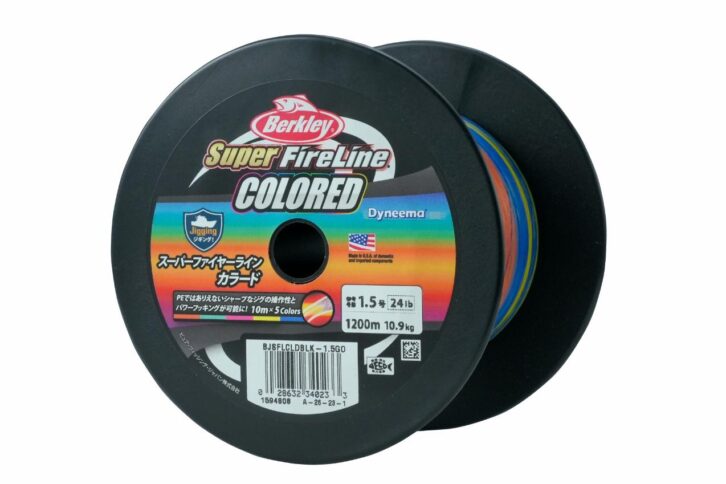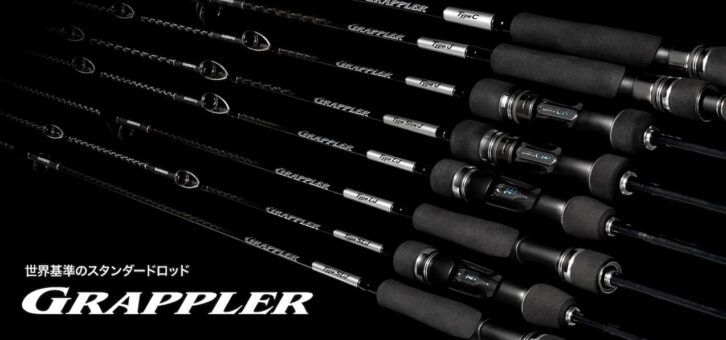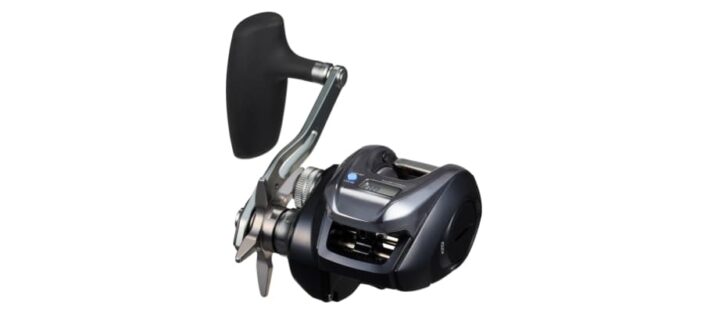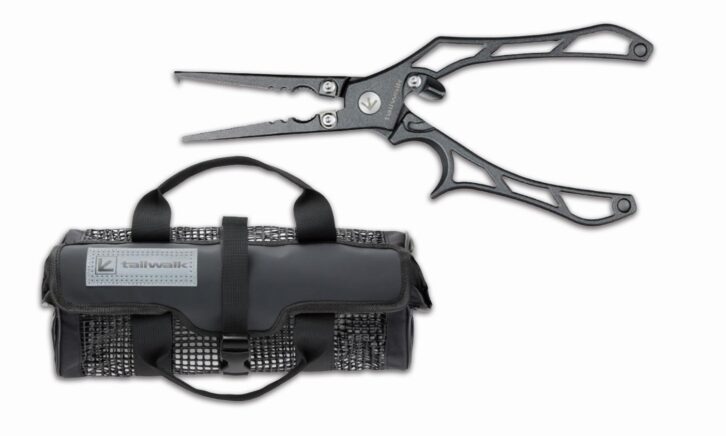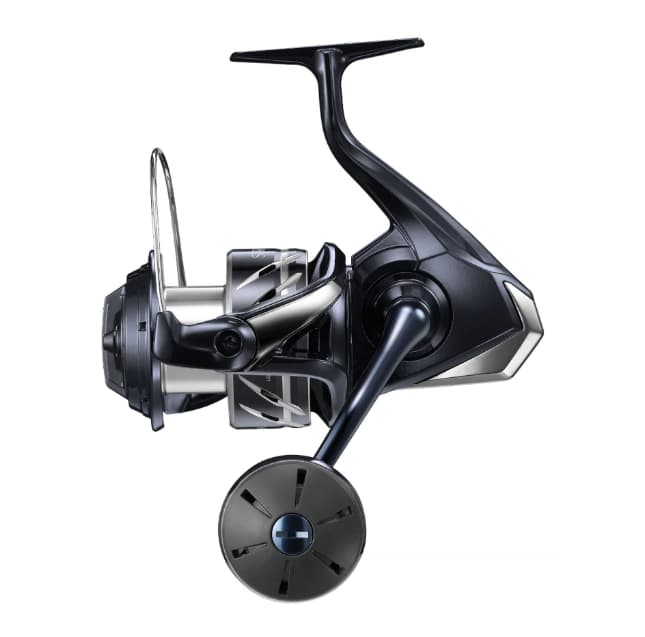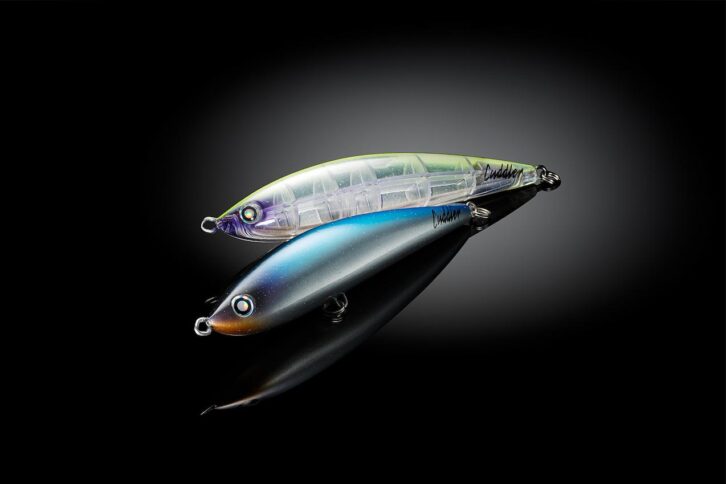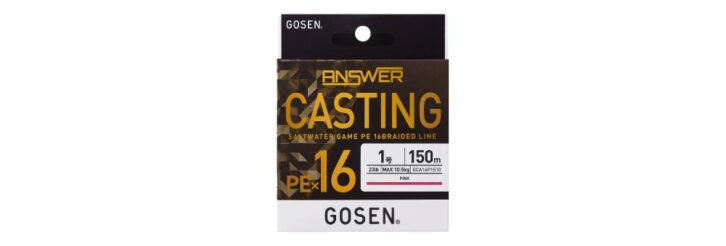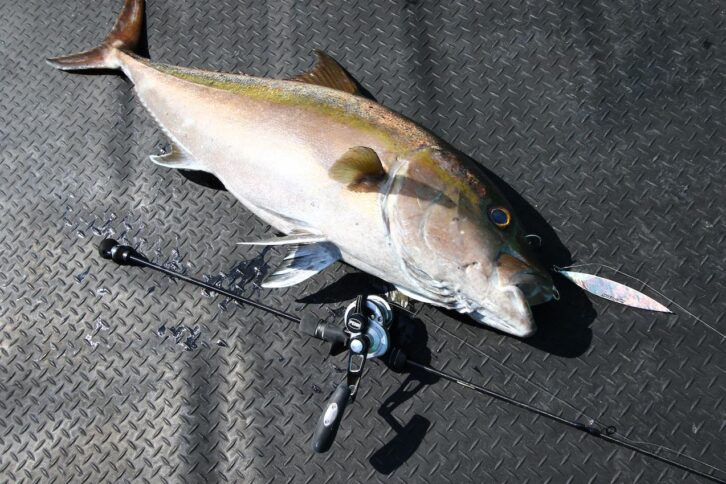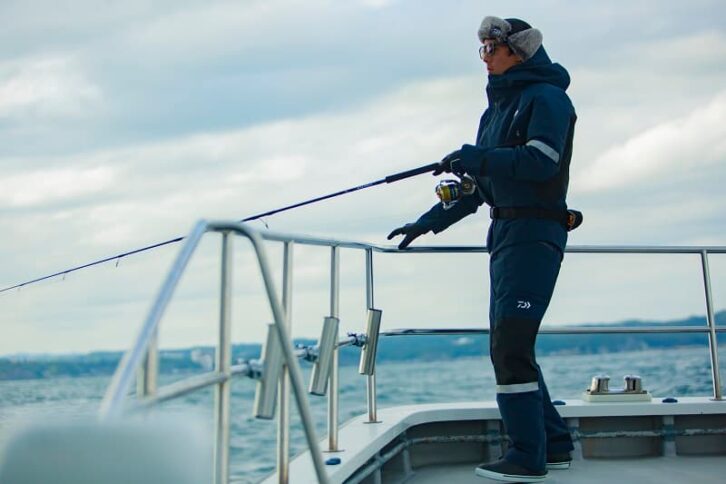Fishing is no fun when the fish are gone!
Will the released fish live properly? Fishing tackle manufacturer Studio Ocean Mark practices Pop-up Tag Release” Project
Fishing, as a matter of course, is not possible without fish. And the more fish targeted, the more fun anglers can have. Therefore, the idea of releasing fish arises in the hope of protecting resources and ensuring that anglers can enjoy fishing forever, but are the fish really alive? It depends on the fish and how you handle the fish. In particular, what about tuna, which is considered difficult to release due to its supposedly always-swimming ecology? With this in mind, Studio Ocean Mark, a fishing tackle manufacturer, began research last year. And Tokyo University of Marine Science and Technology, a national university corporation, is also cooperating in this activity. Here we would like to report the whole story.

INDEX
Necessity of Release
As I wrote at the beginning of this article, catch-and-release is one of the most necessary things for the future of fishing. Fishermen catch more than anglers! Some may say, “Nothing will change if anglers let them go,” but if there are fewer fish, there will be an uproar not only about fishing, but also about the “impact of keeping them in fishing. Then regulations will be made, and fishing will become impossible. The fact that anglers are allowed to keep without restrictions assumes that there are plenty of fish. However, what we are writing here is not a recommendation to catch and release any fish. The reporter himself keeps fish even if he is a professional angler, fishing tackle manufacturer, or other angler who recommends release. We want to eat good fish. However, they must be abundant fish that will not deplete the resource, and they must consider the size, number of fish, and time of year to keep them (do not catch them during the spawning season, etc.), and of course, if there are rules, they must follow them. They know and feel that if the fish disappear, they will not be able to enjoy fishing.
When I talk with many anglers, I often hear them say, “We used to catch fish a lot! I often hear them say, “I used to catch fish a lot in the old days! This may be due to changes in the marine environment, and it may also depend on the type of fish, but there are many fish that have actually become scarce. We are entering an era in which both fishing and angling must be conducted with a firm awareness of resources. The 14th of the SDGs (Sustainable Development Goals), which are being implemented worldwide, is to “protect the abundance of the oceans,” and this is something that needs to be considered on a global scale.
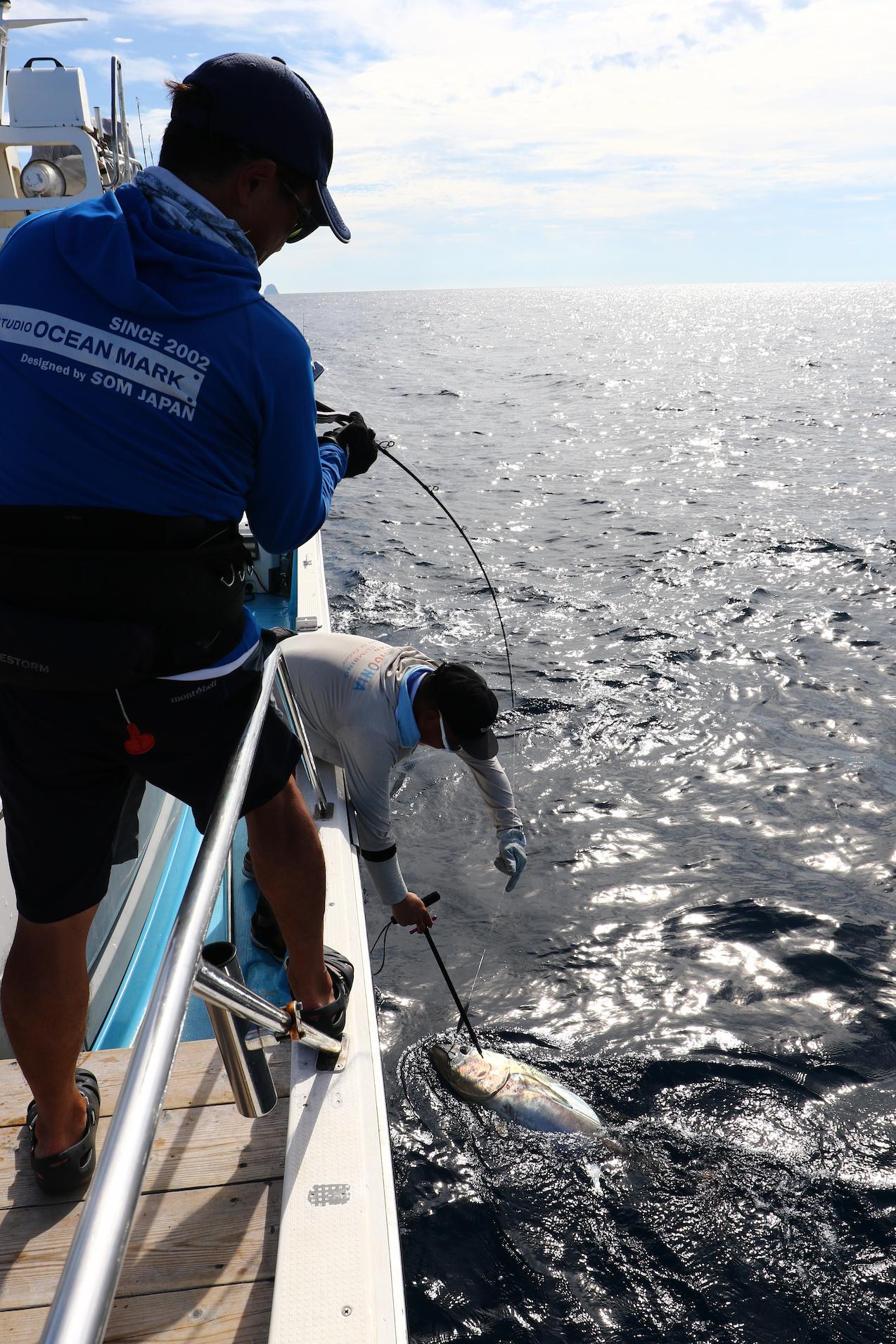
We release fish so that we and future anglers can enjoy fishing forever. If the fish are gone, the fishing will cease. During our coverage of the bluefin tuna release, most of the fish were released without being brought on board.
The method of release and its tools
Anglers sometimes release fish they have caught, but there are various ways to do so. The method also differs depending on the fish. Some fish are violent when brought on board, others are unable to dive due to the swelling of their internal buoyancy bags caused by being reeled in from near the sea bottom, and still others are strong or weak when released from the sea. I will omit the details of how to release each type of fish, but they all have one thing in common: try not to weaken the fish as much as possible. It is important, of course, to do this quickly after catching the fish, but it is also important to avoid touching the fish as much as possible. The best way to do this is not to bring the fish on board or ashore, but to remove the hook and release it directly without touching the fish. Touching the fish with your hands will cause no small amount of damage to the fish. However, depending on the fish, it may be difficult to remove the hook without bringing the fish on board or ashore. Even when such a fish is taken in with a net, it is best to avoid touching the fish as much as possible.
Studio Ocean Mark, a fishing tackle manufacturer, was one of the first in the fishing tackle industry to develop and market an item that holds the fish firmly without touching it with the hand and ensures that the hook can be removed. The first item to be introduced was the Ocean Grip, a fish grip that grips and holds the fish’s mouth. When the first Ocean Grip was released, only a few fish gripping items were available from overseas, but the company developed a model that was easier to use. Today, similar fish gripping items are available from a variety of manufacturers, but the Ocean Grip is a favorite of many anglers because of its superior performance.
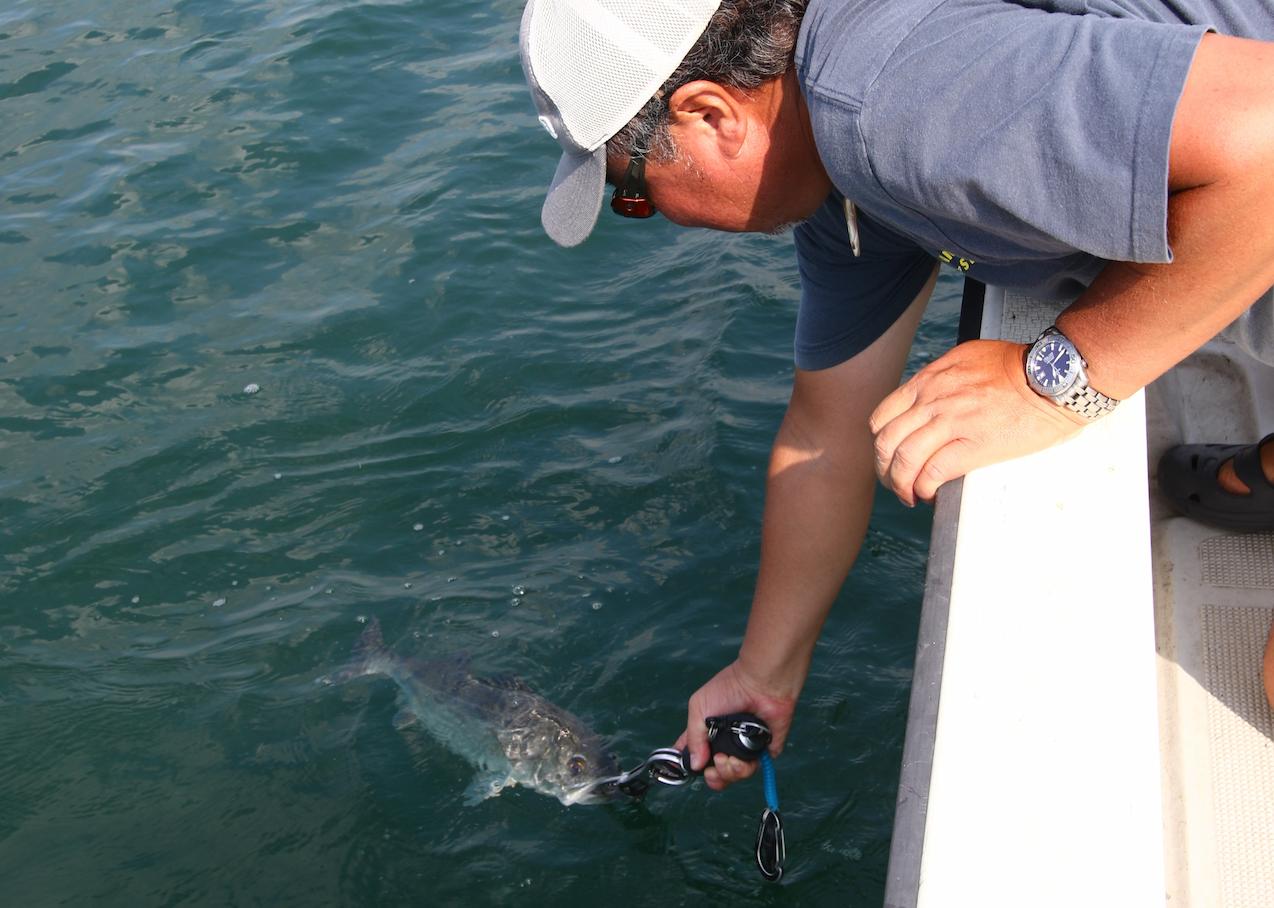
Fish can be damaged just by human touch. They can also be injured when they get out of control on board. When humans touch fish, they can also injure their hands. The Ocean Grip was created to eliminate these problems. Pulling the lever opens the claw and clamps the fish’s mouth, a product that has now become commonplace.

Later, a hook remover was introduced as an item to remove hooks. The hook remover was launched with a structure that grips the hook, a hook tilting structure that makes it easy to remove the hook, and robustness so that hooks that have become stuck in the mouth can be removed safely and easily. This one is also used by many people in fishing where releases are frequent. And both items have so far been released for different uses and evolved from the initial model.
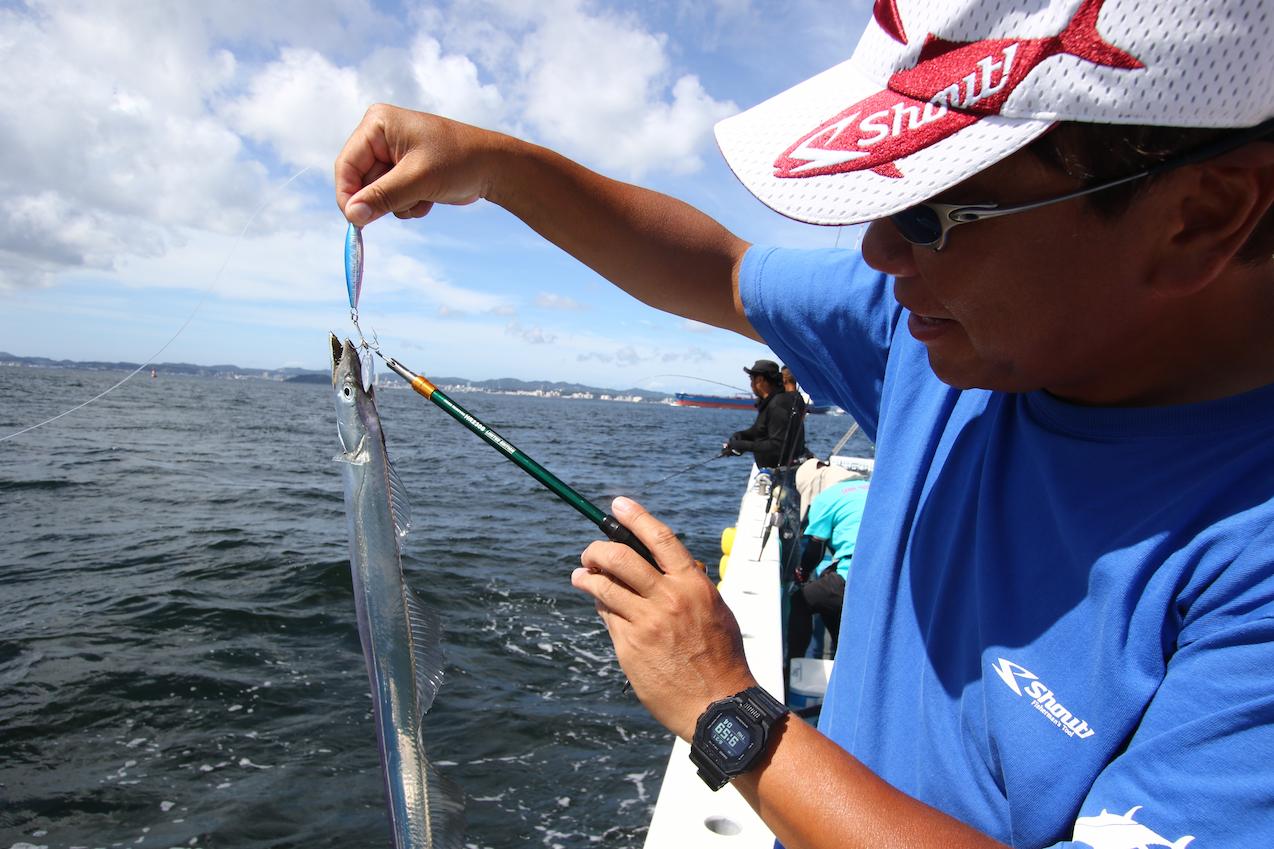
The hook remover has a structure in which the claw at the tip closes when the lever is grasped. The hook can be held firmly and easily removed with a twist of the wrist. It can also be switched to a mode in which the hook is tilted for easy removal. The product is sold in a variety of sizes, from small to large, depending on the application.
Release Methods for Investigations
Generally, fish are released by returning them to the water, but in the ocean, fish are sometimes tagged and released for ecological research. One such method is tag and release. This is also called tag-and-release, in which a numbered spaghetti tag is attached to the fish and released. When the fish is caught again by fishing or angling, the tagged number is reported and the distance traveled and size change can be determined. This release method is often used for research purposes, but it is necessary to “catch” the fish in order to obtain a variety of results.
There is also a research release method that can provide more reliable information on the subsequent movements of released fish. That is the “pop-up tag release (sPAT; Wildlife Computers)” mentioned in the title. This is a pop-up tag, a tag developed for surveying large pelagic fish, with a sensor to estimate sunset and sunrise times and a pressure sensor to estimate water depth, and a memory to store them. The tag is designed to leave the fish’s body after a pre-set period of time, and when it floats, the accumulated data is caught on land and the fish’s movements can be monitored. Pop-up tags are used to study the migration and behavior of large fish such as tuna and swordfish, but their high cost makes it difficult for individuals to hit them in large numbers like spaghetti tags. However, even if they are not harvested, they have the advantage of providing data for a certain period of time after release.
The question is: “Do the released fish really live properly?” . If you have such a question, pop-up tags are limited to large fish, but they can tell you how far a fish has moved up or down in depth after release, and if you see movement, you know for sure that the fish is alive.
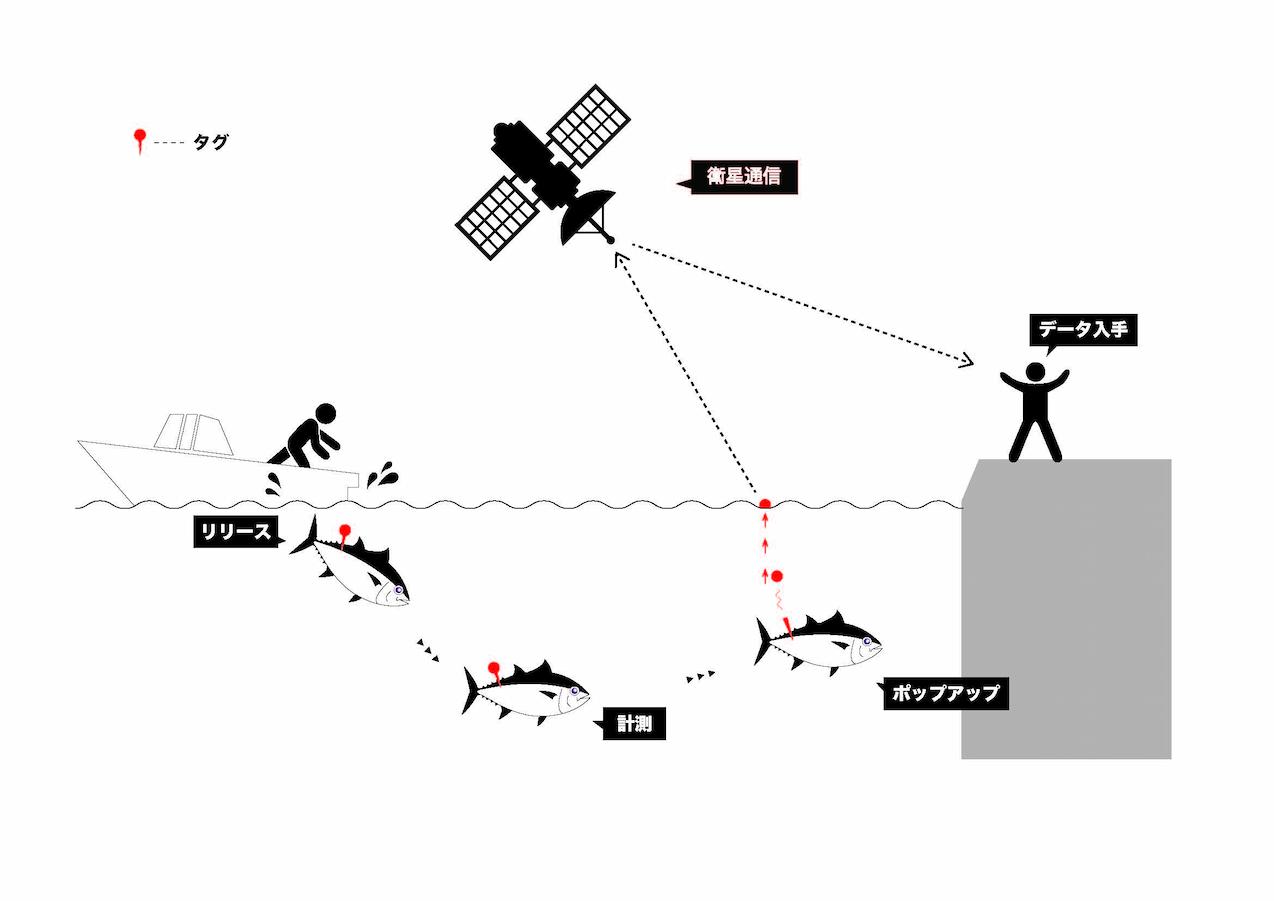
[Pop-up tag release]
After a certain period of time, the part of the fish that stores the data leaves the fish’s body and floats away, allowing the satellite to catch the data. The data is transferred from the satellite to land. The system is used to study large migratory fish.

The photo shows a pop-up tag. A wire part is driven into the fish’s body, and after a certain period of time, the part in this photo floats back to the surface.
Current release methods for bluefin tuna
To date, there have been few bluefin tuna release surveys in Japan. Bluefin tuna breathe by taking in seawater through their mouths as they swim, and if they stop swimming, the fish is severely damaged and weakened. However, in some foreign countries, surveys using pop-up tags are in progress, and the results are estimated to be over 90% depending on the time it takes to catch the fish. But different locations could yield different results. Then a survey is necessary.
Therefore, Studio Ocean Mark began releasing pop-up tags in-house last year in 2022, based on the idea that catch and release is an effective way to enjoy fishing without reducing resources as much as possible. At the same time, they are researching how to release them safely and securely on their own. I had the opportunity to cover such activities in early August 2023 off the coast of Matsumae, Hakodate. The members were Takashi Otsuka, representative of Studio Ocean Mark, Akihiko Hiranaka of North Cast, a lure store in Sapporo that leads the bluefin tuna game in Hokkaido, Professor Seiji Akiyama of the Tokyo University of Marine Science and Technology’s Department of Marine Bioresources, and Assistant Professor Takanori Miyamoto of the same department. The fishing boat was Lobster, a cooperative fishing boat that agrees with the idea of Studio Ocean Mark’s release project. It was an all-release fishing trip. The current practice at Studio Ocean Mark is as follows.
(1) The angler brings the bluefin tuna to the boat’s edge, the captain grabs the leader, and at the same time, carefully threads the gaff from the inside of the mouth to the lower jaw, or kanuki. The head side of the tuna has a high concentration of nerves, so be careful not to damage it.
Once the bluefin tuna is held, it is quickly brought on board. The lobster boat that cooperated with us this time can open the rear of the boat, which makes it easy to pull up the bluefin tuna. It is difficult and takes too much time for heavy fish to be raised on board with a normal port. The best structure would be a vessel like a lobster, which is easily structured to raise the fish overboard.
(3) During the above exchange, the boatmate prepares a sheet with a length scale on it. In addition, a hose to feed seawater into the bluefin tuna’s mouth, a wet towel, and four ocean grips (OG2920HD or other model that can weigh up to 20 kg) are prepared, and the grip tips are hung over the four corner holes on the sheet. Wet the sheet.
4) Pull the bluefin tuna up onto the sheet, put a wet towel over its eyes to prevent it from getting out of control, and pour seawater through its mouth with a hose. Quickly remove the lure, check its length on the scale on the sheet, and stick a pop-up tag in it.
(5) Four people lift the fish grips and check the weight scale on each fish grip (add the weight of each memory to make the fish weight). The fish is then released as it slides off the sheet. In this case, we did this from the open area at the rear of the boat.
This process is done with the cooperation of everyone. This requires at least four people. This time, the smaller fish weighing less than 30 kg were released using the HR550L-PRO hook remover model without lifting them on board, while the 60 kg fish were released with a pop-up tag. From the time the 60 kg bluefin tuna was caught to the time it was released, it took only 1 minute and 30 seconds, according to the information in the photos I had taken. Incidentally, the pop-up tag was designed for fish weighing 30 kg or more. There is no upper limit to the size of the fish to be hit, but the upper limit was set at about 60 kg as a size that could be brought up to the boat within a certain amount of time and measured on board. We ventured into Hakodate in early August, aiming for the high water temperature period when many fish of this size are migrating. There were of course some extra-large ones in the waters off Hakodate, but the target size of 30 to 60 kg was also in abundance.
Actual release

Reel the fish up to the boat’s edge. Ideally, the fish should be reeled up in a short time so as not to weaken it. The 60 kg fish we released took about 30 minutes to reel to the side of the boat.
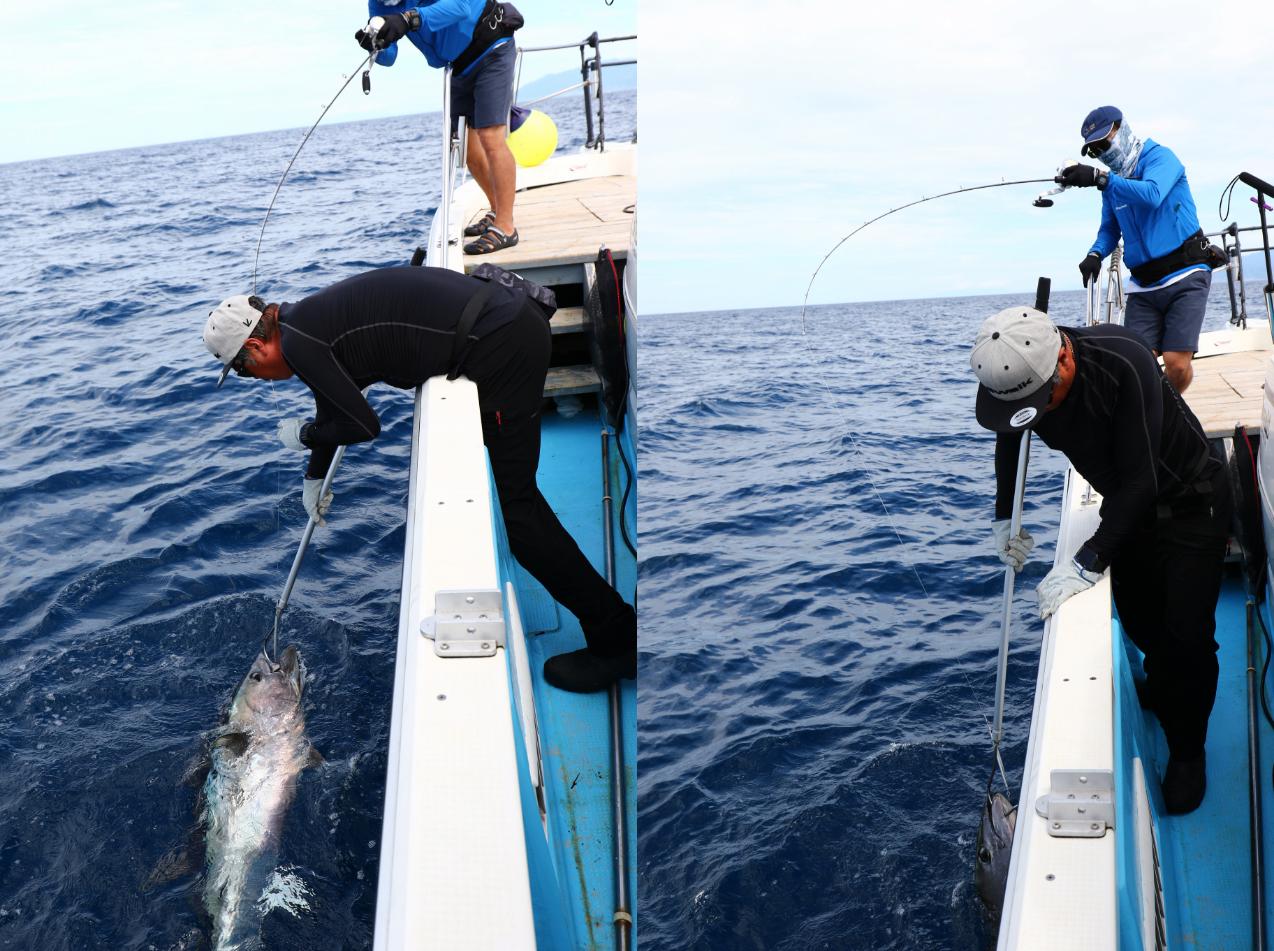
Once the angler has brought the tuna to the side of the boat, the gaff is carefully placed on the lower jaw (left photo). Once the gaff was placed on the lower jaw, the angler moved to the rear of the boat to pull the fish overboard (right photo).

Sliding the bluefin tuna up from the rear of the boat. *The recreational fishing boat Lobster, which cooperated with us this time, has a structure that opens at the rear of the boat.
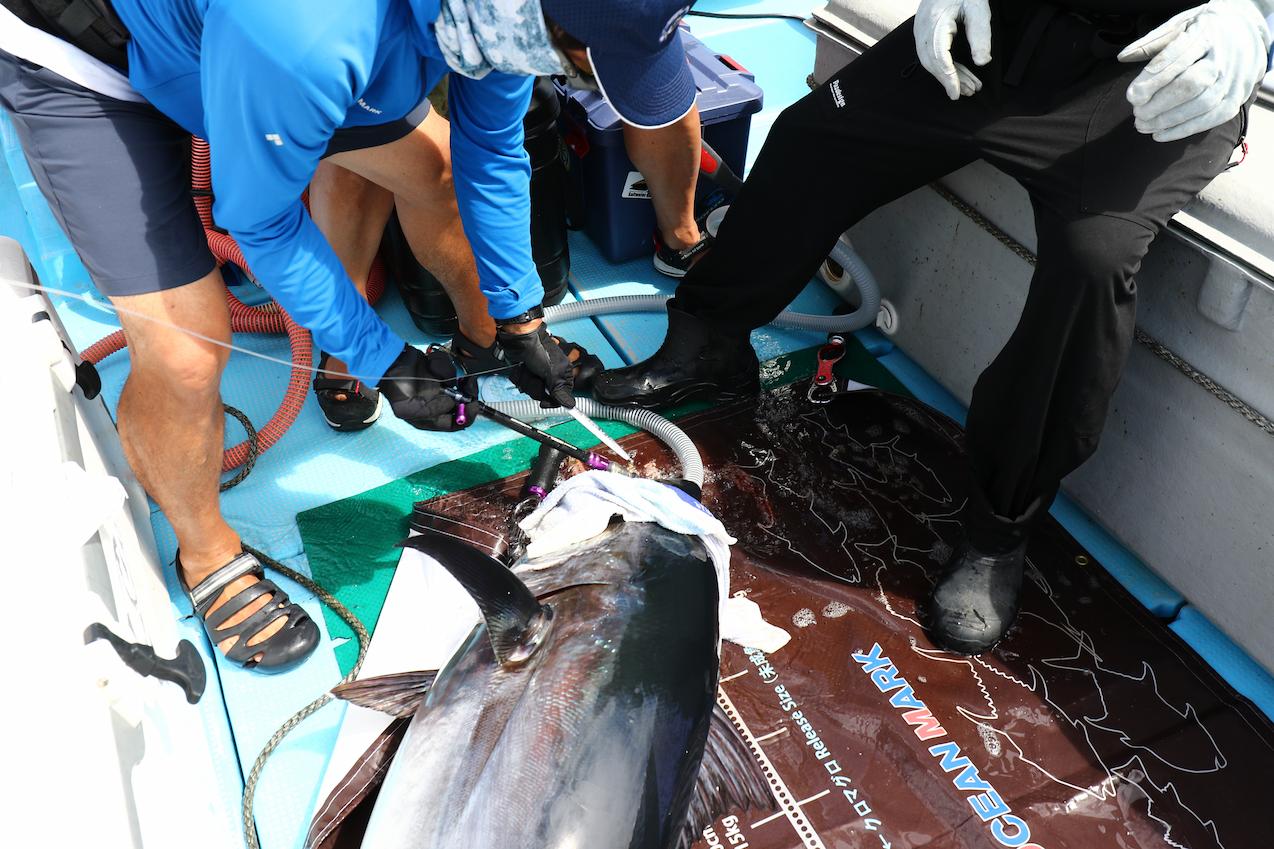
Place the bluefin tuna on a wet sheet, quickly drape a wet towel over its eyes, and remove the lure.
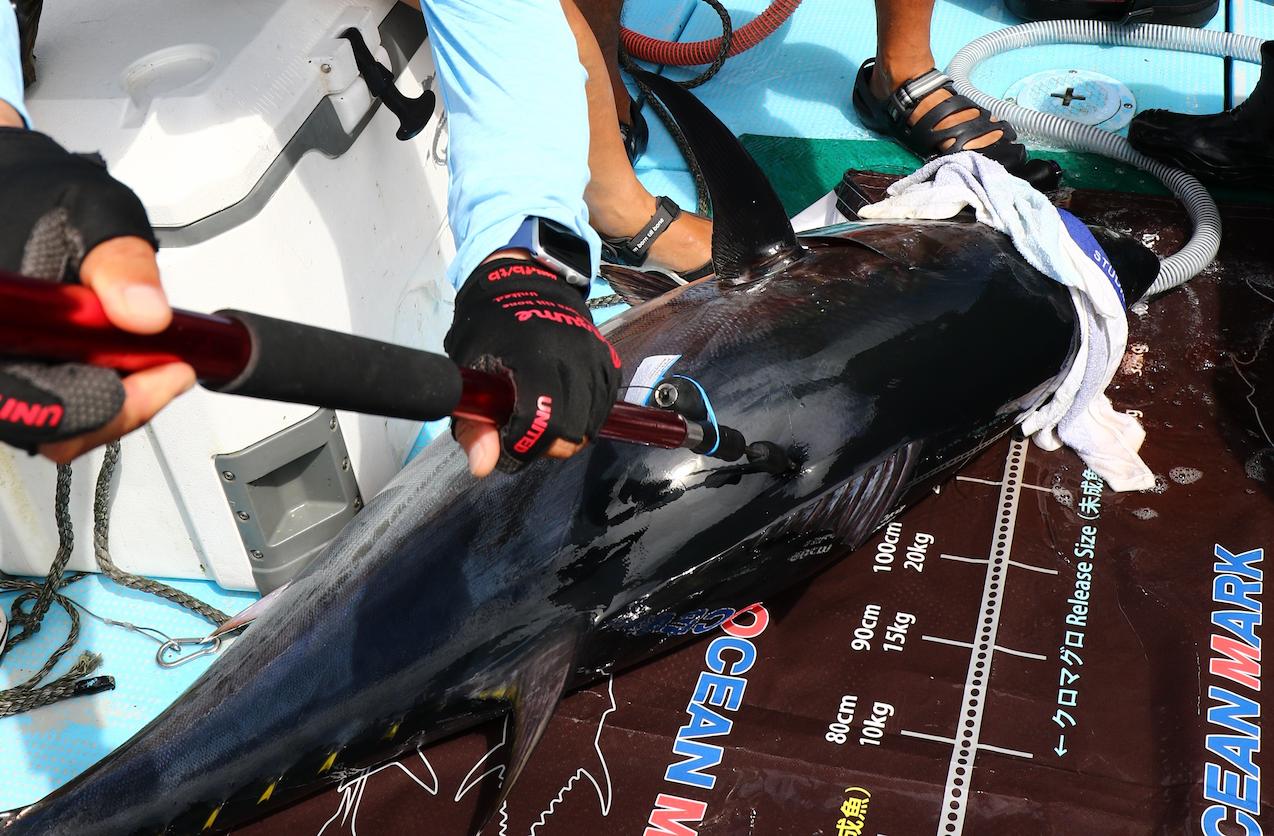

Strike a pop-up tag on the side of the dorsal fin.
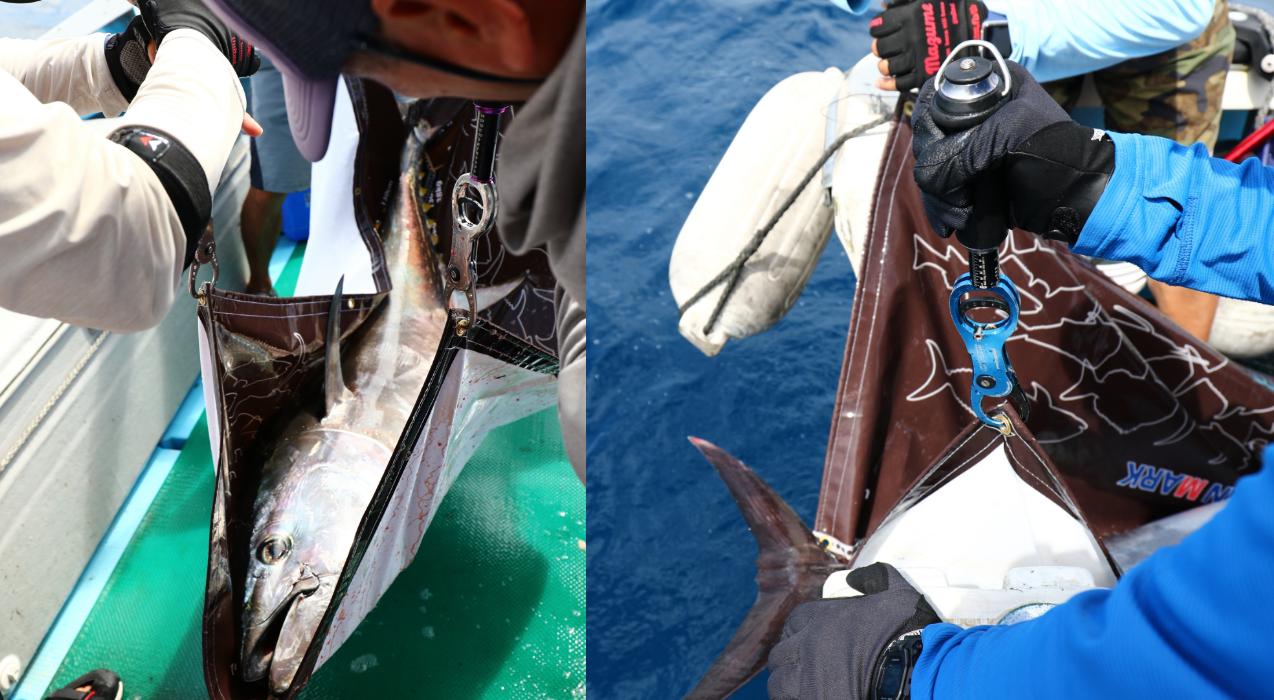
Lift and weigh with ocean grips pre-set on the seat. Release as it slides from the back of the boat. From the time it was raised on board to this point, it took about 1 minute and 30 seconds.

Smooth and successful release. It would not have succeeded without everyone’s cooperation.
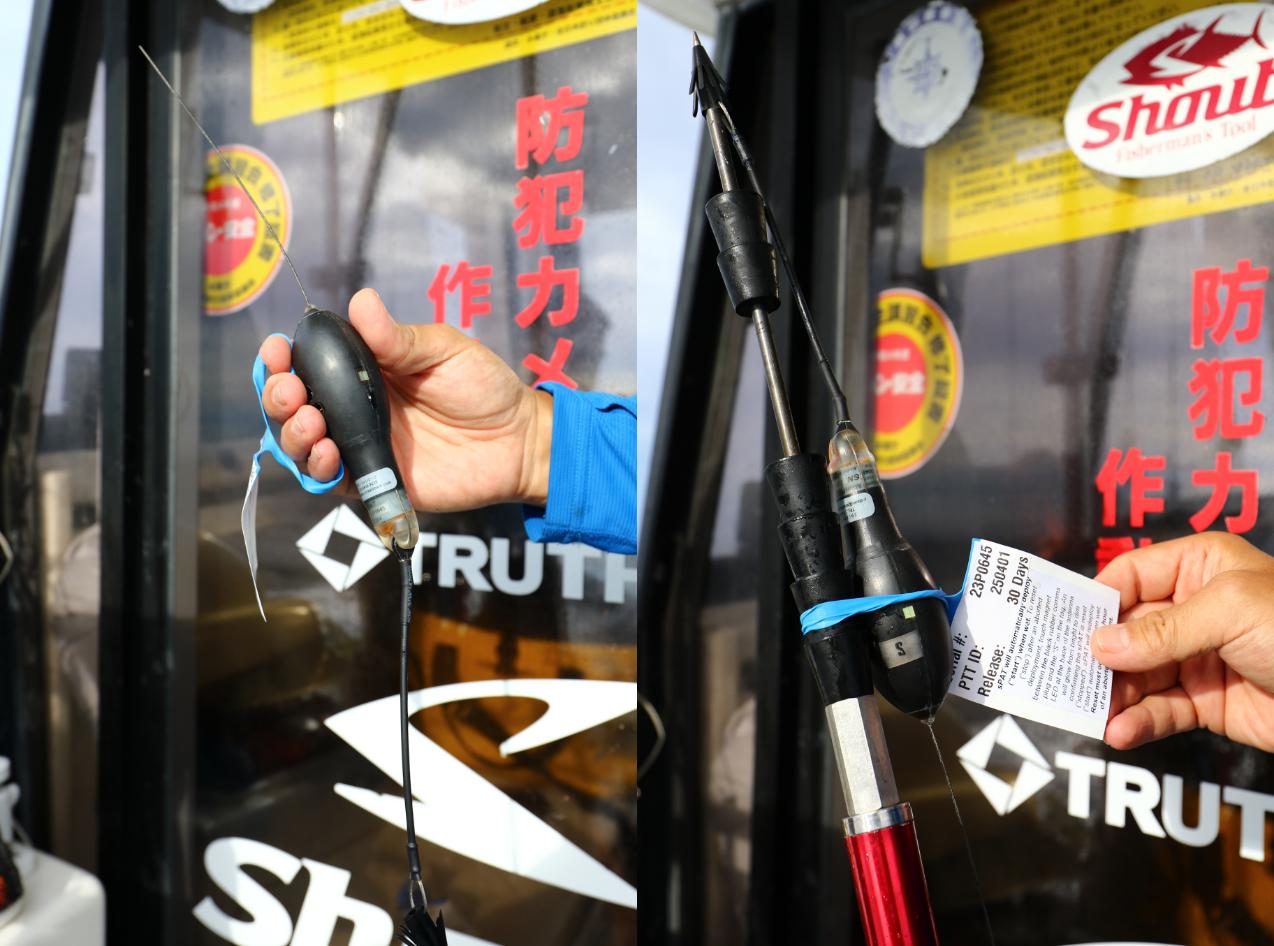
On the left is the pop-up tag we used this time. This is set on a homemade tag stick and inserted into the fish body.
Result of release
The purpose of this release project was to find out whether bluefin tuna live after release. Professor Seiji Akiyama of Tokyo University of Marine Science and Technology, who was on board this time, has been supporting this project since the start of the release last year. This time, he actually showed us how to release the fish, and also helped us exchange releases after the catch. In addition, Studio Ocean Mark has exchanged letters of intent with Professor Seiji Akiyama on this activity and will have him publish the data in a paper when it is complete.
As for the results of the pop-up tagging, the tag emerged in early September. And the bluefin tuna were alive. The data is shown in the table below. The fact that it repeatedly moves up and down every day is evidence that it is alive, and the way this activity occurs is also interesting. Incidentally, the place where the tag floated was off the coast of Shakotan. In fact, when we asked about the status of bluefin tuna off Hakodate-Matsumae after this event, we were told that bluefin tuna had become scarce. We can assume that along with the pop-up tag results, the school had moved north.
So far, Studio Ocean Mark has hit two pop-up tags and both have confirmed survival after release. However, two tags is still not enough. We need to pop a few more tags and get more data. However, because of the high cost of these tags, it is not possible to do so one after the other. From next year onward, Studio Ocean Mark hopes to obtain more data for the future of tuna fishing by asking for cooperation from the fishing industry, tuna fishing equipment manufacturers, and fishing boats. Incidentally, the company has already received financial support from Uoya Corporation, Eitech Corporation, and NorthCast as project partners.
Result of pop-up tag release in 2023


The released bluefin tuna are shown to be alive as they repeatedly move up and down to ranges deeper than 50 m and near the surface of the water. This is because such vertical movement would not occur if they were dead.
Tuna Tackle
As mentioned above, this fishing trip was conducted on an all-release basis. Therefore, a catch in a short time was required to avoid damaging the bluefin tuna as much as possible. Therefore, the main method of fishing was jigging using a bait reel, which has torque and makes it easy to close the distance with the tuna. The captain would instruct the angler on the layer of the water where the tuna were reacting, and the angler would search for the target by using slow pitch jerks, mainly falling. The jigs used were mainly 300g-400g so that they could quickly sink to the indicated layer and not be rolled up by the tidal current. For rods, we asked Mr. Hiranaka of North Cast for his recommendation, and he said that the Takami Technos MOZ624LM NC Custom and CBONE’s Braver 66/6 are the best match. As for reels, we wanted reels with high torque and high drag performance, and we wanted to pull in the fish quickly after a hit, so we used Studio Ocean Mark’s NO LIMITS Blue Heaven L100Lo and L80Lo (low gear model; drag max. 14 kg). The angler used Studio Ocean Mark’s NO LIMITS Blue Heaven L100Lo and L80Lo (low gear models with a drag max. of 14 kg). When fighting tuna, it is necessary to reel in as much as possible to shorten the distance between you and the tuna. This is why this model has increased reeling power for maguro jigging. The line used is PE line No. 6 or No. 8. Leader was 130lb or 150lb. Of course, ocean grips and hook removers were a must-have item. As a result, we released six bluefin tuna in two days.

Mr. Hiranaka of North Cast, one of the leaders of the bluefin tuna game in Hokkaido, recommends the Takami Technos MOZ624LM NC Custom jigging rod for bluefin tuna. This custom model is sold by North Cast. Its bendable performance allows anglers to put more pressure on bluefin tuna during a fight. The reels are Studio Ocean Mark NO LIMITS Blue Heaven L100Lo and L80Lo with increased reeling power for tuna.

Jigs used are Namara Jig 300-400g, Namara Jig S.T. 300, etc. One hook is set on the tail. North Cast original hooks are used.

Ocean Grip and Hook Remover HR550L-PRO, essentials for tuna release, are items to have on hand since bluefin tuna are currently subject to the rule of small release, regardless of whether or not large fish are released.

The drag is set at 10 kg with STRIKE for the L80Lo model. After a hit, first let the fish run with this drag value, and when it stops moving, tighten the drag even more and move on to the fight.
The release of bluefin tuna in Japan has only been proven in the past few years. However, manufacturers, professional anglers, store staff, and others have been seeking and researching ways to do so, and the method is taking shape. We need the cooperation of many anglers so that bluefin tuna fishing can be enjoyed recreationally forever, and Angler’s Time will also cooperate and look forward to a good future for anglers.
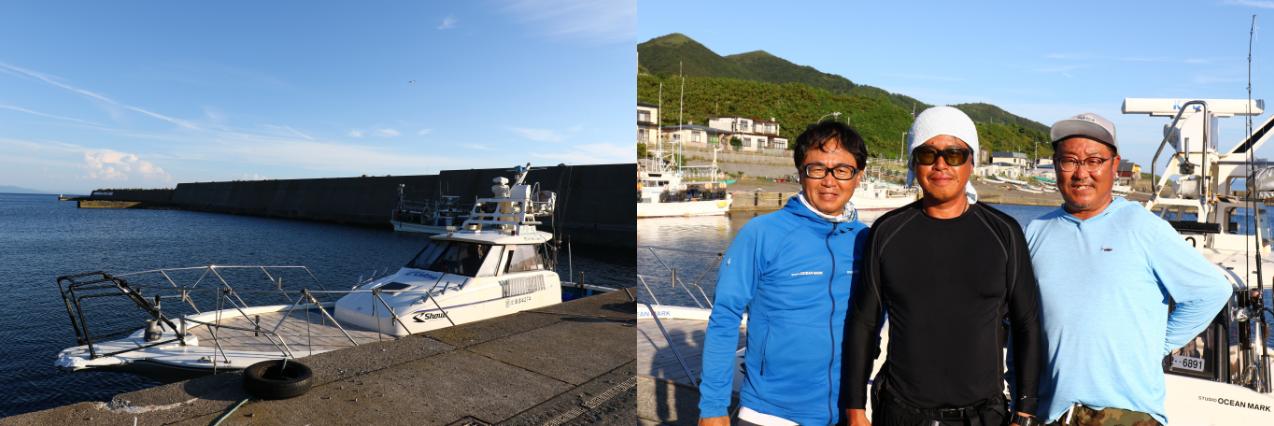
Captain Kinoshita of Lobster (center), Mr. Hiranaka of North Cast (right), and Mr. Otsuka of Studio Ocean Mark (left) for their help. They are all thinking, acting, and cooperating for the future of bluefin tuna fishing.
The companies cooperating in funding the pop-up tag project are
Uoya Corporation
A-Tech Corporation
North Cast (Sapporo)


